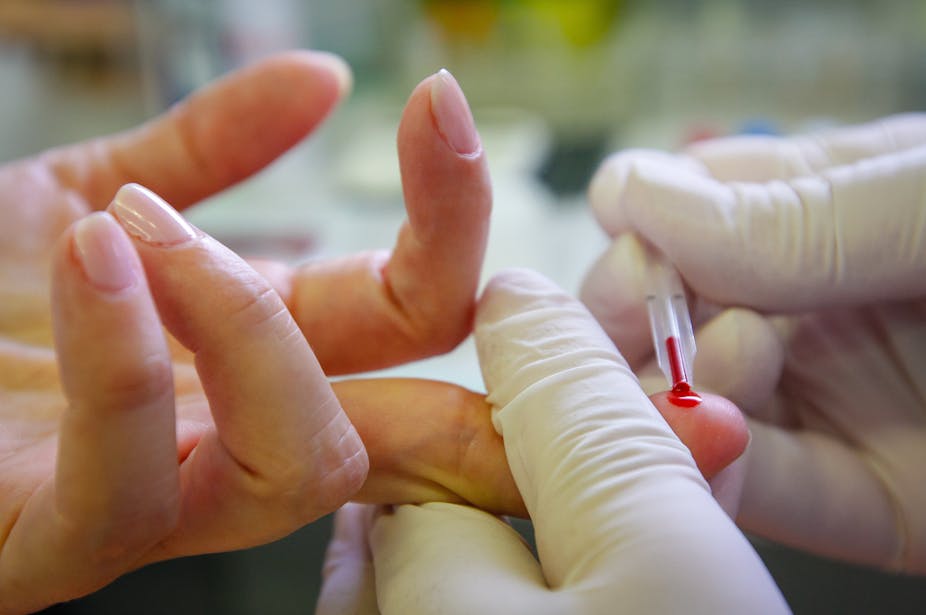Over 20 million people worldwide have schizophrenia. This mental illness has a number of serious symptoms – such as seeing or hearing things that aren’t there (hallucnations), having irrational ideas (delusions), apathy, blunting of emotions and loss of pleasure. While the condition is usually managed with so-called antipsychotic drugs, these drugs don’t work equally well for everyone – meaning some have to try more than one kind of treatment before they find one that helps them. Around one-third of patients even fail to respond to two or more treatments they’re prescribed. But a new blood test device we helped to evaluate may provide a fast, easy-to-use solution for these treatment-resistant patients.
Treatments for schizophrenia work by reducing the effect of the neurotransmitter dopamine in the brain. Dopamine is an important chemical in our brains, involved in reward, attention and learning. Patients with schizophrenia have excess dopamine activity. Antipsychotic drugs suppress excess dopamine activity, leading to improvements in symptoms. But antipsychotic treatments tend to work better for people whose main symptoms are hallucinations and delusions.
For those patients who fail to respond to two antipsychotic medications, a psychiatrist may consider prescribing the medication clozapine, which is one of the most effective drugs for schizophrenia. But despite clozapine’s widely demonstrated effectiveness, it remains under used.
One factor in its under use is that, unlike other treatments, doctors need to conduct regular blood tests. These happen every week for the first 18 weeks after clozapine is prescribed, then fortnightly for up to one year, followed by monthly tests. These are done to ensure the dose is correct for a patient. If the dose is too low, it can make the treatment ineffective. But if it’s too high, it may lead to serious side effects, such as seizures, or a drop in white blood cells – important for fighting infections. These side effects are also why it’s not used as the first treatment.
Additionally, some patients dislike having to provide regular blood samples. Busy clinical teams may also be put off a treatment that requires them to carry out regular blood testing. This could leave patients with ineffective treatments that make it more difficult to manage symptoms.
Portable blood test
Our research team has worked with a diagnostic testing company to develop a solution for under use of clozapine. As a result, they’ve created a portable device which allows clinicians to easily monitor the levels of clozapine in a patient’s blood almost instantly.

This new device means doctors can adjust doses for patients according to how they’re responding to treatment or the side effects they’re having. It also means that doctors can get important information on how drug levels may have fluctuated as a result of certain lifestyle changes (such as if a person got ill, or quit smoking).
Currently, clozapine levels are tested by drawing blood from a vein. But it takes almost a week after a sample is taken to get results. This means a person may be on an incorrect dose for a long time. People who are nervous around needles may also not want to undergo regular tests.
But this device uses a simple fingerprick blood sample to measure clozapine levels in only five minutes. This form of blood sampling is faster and less invasive – which is particularly beneficial for repeated testing, and may make it easier for patients who don’t like blood tests.
To understand how this device worked compared to regular blood tests, we conducted a study which looked at 300 patients in South London. We found that the new fingerprick blood test was much easier for both the patients to use and the clinicians to administer, and both patients and clinicians liked the fact that they were able to see the result shortly after testing. This meant that the patient could be told immediately whether their clozapine dose needed to be increased or reduced. Patients said that as a result they felt more involved in their care. Importantly, the new test was just as accurate as the standard one.
It’s important for patients with schizophrenia to have fast, accurate information on their blood levels to ensure the treatment they’re receiving is effective and safe. We are confident this more personalised approach to treating patients can improve care and the effectiveness of treatment. We are now evaluating the same approach for testing the blood levels of other antipsychotic medications. We also hope to make this device available as part of routine clinical care.

